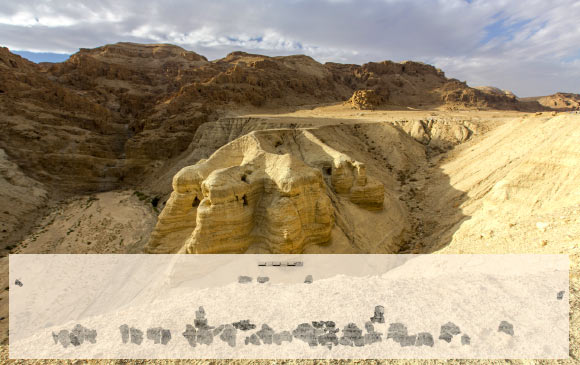A team of scientists from the Department of Bible Studies at the University of Haifa, Israel, has deciphered one of the last obscured parts of the Dead Sea Scrolls, a collection of almost 1,000 ancient manuscripts in Hebrew, Aramaic, and Greek discovered in caves near Qumran in the Judean Desert in the 1940-50s.
Members of the Qumran sect, who referred to themselves as the Yahad (‘Together’) community, were a fanatical group that lived a hermitic life in the Judean Desert. They wrote numerous scrolls, including a small number written in cryptic script.
The newly-deciphered Qumran scroll (dubbed 4Q324d) — reconstructed from 60 tiny fragments, some smaller than one cm2 — contains information about the most important dates in the sect’s 364-day calendar.
“This calendar was involved in one of the fiercest debates between different groups during the late Second Temple period,” said University of Haifa researchers Dr. Eshbal Ratzon and Professor Jonathan Ben-Dov.
“The lunar calendar, which Judaism follows to this day, requires a large number of human decisions. People must look at the stars and the Moon and report on their observations, and someone must be empowered to decide on the new month and the application of leap years.”
“By contrast, the 364-day calendar was perfect. Because this number can be divided into four and seven, special occasions always fall on the same day. This avoids the need to decide, for example, what happens when a particular occasion falls on the Sabbath, as often happens in the lunar calendar.”
“The Qumran calendar is unchanging, and it appears to have embodied the beliefs of the members of this community regarding perfection and holiness,” they explained.
The Qumran sect’s calendar describes two special occasions not mentioned in the Bible, but which are already known from the Temple Scroll of Qumran: the festivals of New Wine and New Oil. These dates constituted an extension of the festival of Shavuot as we know it today, which celebrates the New Wheat.
According to this calendar, the festival of New Wheat falls 50 days after the first Sabbath following Passover; the festival of New Wine comes 50 days later; and after a further interval of 50 days, the festival of New Oil is celebrated.
The calendrical scroll 4Q324d also provides some surprises.
The researchers were aware from the previous scrolls that the members of the sect celebrated the transition between the seasons, adding a special day for each of the four changes of season. Until now, however, the name of these special days has remained unknown.
The present scroll reveals that these days were referred to by the word Tekufah. In today’s Hebrew, ‘Tekufah’ translates into the word ‘period.’
“This term is familiar from the later Rabbinical literature and from mosaics dating to the Talmudic period, and we could have assumed that it would also be used with this meaning in the scrolls, but this is the first time it has been revealed,” the scientists said.
“The scroll also provides additional information about the customs of the authors of the scrolls,” they added.
“It emerges that the person who wrote the scroll — probably one of the leaders of the sect familiar with the secret code — forgot to mention several special days marked by the community.”
“Accordingly, another scribe was forced to correct the errors, adding the missing dates in the margins between the columns of text.”
“The scroll is written in code, but its actual content is simple and well-known, and there was no reason to conceal it. This practice is also found in many places outside the Land of Israel, where leaders write in secret code even when discussing universally-known matters, as a reflection of their status.”
“The custom was intended to show that the author was familiar with the code, while others were not. However, this present scroll shows that the author made a number of mistakes.”
“This scroll includes numerous words and expressions that we find later in the Mishna. This shows once again that many of the subjects discussed by the Scribes several centuries later had origins that predated the Second Temple period,” Dr. Ratzon and Professor Ben-Dov said.
The team’s results are published in the Journal of Biblical Literature.
Source: Sci News

































Leave a Comment
You must be logged in to post a comment.